This post may include affiliate links. Thank you for your support.
This 8-ingredient Asparagus Frittata is so simple to prepare, ready in 30 minutes and made entirely in the oven! Overflowing with crisp asparagus, rich ricotta and fresh herbs, it’s a flavorful egg dish everyone will love! You can easily meal prep this baked egg casserole, making it perfect for every occasion, from breakfast and brunch to light lunches and easy dinners!
Update: This post was originally published in April 2019. I made updates to the post below to include more information about this recipe for asparagus baked eggs. I also added a recipe video along with step-by-step photos so you can see exactly how easy it is to make this frittata recipe with asparagus!
Hi, friends! Today we are celebrating two of my all time favorite things – eggs and asparagus!
Today’s dish is a celebration of the spring season. This asparagus egg frittata rich and creamy, bursting with fresh flavor and inexpensive to make! Not to mention, the leftovers taste absolutely divine! Honestly, it’s the perfect excuse to eat asparagus for breakfast, brunch, lunch and dinner!
If the thought of homemade eggs frittatas scares you, don’t be intimidated! This asparagus frittata recipe is made entirely in the oven! If you can scramble eggs in a bowl and turn on an oven, you can definitely master this asparagus egg casserole!
Table of Contents
About this asparagus frittata recipe
Fluffy, creamy eggs flavored with delicate chives, fresh dill and a touch of tangy dijon mustard; layered with tender, bright asparagus and dolloped with rich, smooth ricotta cheese. Topped with nutty parmesan cheese, more fresh herbs and meaty prosciutto, this Italian asparagus frittata is light, yet hearty and filling!
This frittata recipe with asparagus only requires 15 minutes of hands-on-prep time! Honestly, it’s as easy as boiling (par-cooking) asparagus, whisking eggs, assembling and bake! It’s the perfect baked egg casserole for every occasion – from showers and holiday entertaining to Sunday brunch with the family!
If you’re looking for more simple egg breakfasts, try these delicious recipes next: Avocado and Eggs (Scrambled eggs made in the oven.) Sweet Breakfast Casserole (A make-ahead brunch favorite.), Eggs in a Bagel (Easiest, tastiest breakfast ever.).
Why you’ll love this oven frittata recipe
- Extremely quick to prepare! Elegant eggs and asparagus only requires 15 of hands on preparation.
- Easier than classic frittata! This asparagus parmesan frittata is totally fuss-free and made entirely in the oven! There’s no need to stand over a stovetop and preheat the oven. Win-win!
- Insanely delicious taste and texture! Asparagus baked eggs is luscious, custardy and beautifully rich in texture! Plus, it’s overflowing with tender-crisp asparagus, delicate herbs and not one, but two types of cheeses!
- Easy to customize! You can easily get creative with your frittata! Swap out or add in ingredients based on what you love or have on hand! I love the combination of asparagus and prosciutto; however, smoked salmon is an amazing addition.
- Great way to use up ingredients! Oven Frittatas are the perfect impromptu meal because you can literally add whatever ingredients have hanging around the kitchen.
- Perfect for every occasion! This spring frittata is a hit with everyone – serve it at your next family breakfast or holiday brunch.
- Leftovers are superb! Leftover oven baked frittata makes the perfect quick heat-and-eat meal!
What is a frittata?
Frittata is an Italian egg dish similar to a crustless quiche or omelette. Frittatas have a creamy, custard-like in texture and are often flavored and enhanced with additional ingredients, such as vegetables, meats and/or cheeses.
Frittata vs Quiche
Breakfast frittatas and quiches have a lot in common – both baked egg dishes containing whole milk or cream along with an array of fillings, such as veggies. However, these two brunch meals also have two major differences: the crust and the amount of dairy. A traditional quiche contains a crust and a higher ratio of dairy. On the other hand, a frittata recipe contains no crust and uses less dairy. It’s worth noting that a crustless quiche is nearly identical to a frittata; however, the former will contain more dairy (whole milk or heavy cream).
Traditional frittata vs baked frittata
Traditional egg frittatas are made by the stovetop-to-oven method of cooking. Meaning, you start the eggs in on the stovetop and then move them to the oven to finish cooking. Baked frittatas are made in a casserole dish and cook completely in the oven. Essentially, a baked frittata recipe is easier and less-fussy to prepare than a traditional stovetop frittata!
Ingredients for frittata asparagus
This eggs and asparagus breakfast only requires 8 simple ingredients, along with a few pantry staples! But, don’t let the basic ingredient list fool you – this frittata recipe is so delicious, with plenty of asparagus and a melt-in-your-mouth custardy texture! All baked egg dishes – from frittatas and quiches, to omelettes and even the best scrambled eggs – rely on two simple components: The creamy custard and The fillings. Be sure to scroll down to read about substitutions and easy customization ideas!
Ingredients in recipe for asparagus frittata
- Asparagus: You will need 1 pound fresh asparagus. I recommend using baby asparagus or thin asparagus spears in your frittata – it looks more appealing and it’s easier for serving/eating.
- Eggs: You can’t make a frittata without eggs! You will need 8 large eggs for this recipe. You can use 7 large eggs plus 2 yolks if you prefer an ultra-rich flavor.
- Diary: Dairy, such as milk or cream, is a crucial component of frittatas. This simple ingredient causes the proteins in eggs to coagulate, which gives your frittata that signature silky, creamy, fluffy texture! Classic frittata recipes use heavy cream. This asparagus ricotta frittata uses 1/3 cup of dairy for every 8 large eggs.
- Cheeses: A combination of salty, complex parmesan and rich ricotta adds savory flavor along with a touch of decadence.
- Fresh Herbs: Dainty chives and slightly grassy and citrusy dill lend tons fresh flavor and really bring this dish to life.
- Mustard: Dijon mustard provides a touch of fat and acid, which makes your baked eggs taste more decadent and flavorful!
- Seasonings: A simple pairing of kosher salt and freshly-ground black pepper make all the ingredients shine and the flavors sing!
Substitutions and Additions
- Cheese substitutions: Cheese adds flavor and fat to your egg frittata which provides delicious taste and texture. The variety and amount of cheese is a matter of personal preference. You can use any cheese or combination of cheeses you love in this breakfast asparagus recipe! Gruyere, mozzarella, goat cheese and feta are all delicious with asparagus and eggs!
- Dairy options: The type of dairy you use will directly impact the texture and flavor of your baked eggs. Without this ingredient, your frittata will cook up flatter and denser. You can use heavy cream, half-and-half, or whole milk. Heavy cream will give your egg bake the richest texture and creamiest flavor; while half-and-half or whole milk will offer a slightly lighter mouthfeel (plus less calories and fat). I do not recommend using low fat or fat-free milk, as your eggs frittata will end up slightly watery in taste and texture.
- Onion addition: If I have them on hand, I always add shallots; however, you can use any variety of onion you love! I recommend finely mincing them and soaking them in lemon water (to remove the harsh bite) or quickly sautéing them before adding them to the egg mixture.
- Meat addition: You can easily transform this asparagus and eggs recipe into a meat lover’s dream by adding crispy bacon, leftover ham or breakfast sausage! Just make sure the meat is fully cooked before adding it to the frittata egg custard!
Asparagus frittata variations
One of the best things about fluffy frittatas (or any egg casserole, really) is their versatility! Appropriate for breakfast, brunch, lunch and dinner, you can prepare veggie frittatas well in advance and they are the ideal vessel for leftover meats, cheeses and vegetables! Below are a few easy and delicious ways to jazz up this recipe for asparagus frittata.
6 frittata variations
- Ham and asparagus frittata: If you are making this dish after the winter holidays or Easter, add some leftover holiday ham to your eggs!
- Asparagus, mushroom and feta: If you are feeding a vegetarian crowd, the combination of asparagus, mushrooms and feta cheese is fabulous in a frittata!
- Salmon and asparagus: Turn your frittata into an elegant, restaurant-worthy dish by adding leftover grilled salmon or smoked salmon to your frittata!
- Bacon asparagus: Add salty, crispy bacon for a savory egg dish with a touch of meaty deliciousness!
- Crab and asparagus: If you are looking to impress, lump crab, asparagus and eggs are a glorious match made in culinary heaven!
- Spinach asparagus frittata: For a baked egg frittata worthy of a spring celebration, throw in some fresh baby spinach. Just be sure to cook and thoroughly drain the spinach first!
How to make asparagus frittata at home?
This egg recipe is fuss-free and incredibly easy to prepare. Since this frittata is cooked entirely in the oven, it’s mostly hands-off and perfect for breakfasts and busy weeknight dinners!
(Scroll down for the detailed measurements and instructions in the printable recipe card at the bottom of the page.)
- Preheat oven to 375 degrees F. Line a 9-inch square baking pan with two sheet of parchment paper, cut to fit inside the pan with the edges slightly hanging over.
- Blanch asparagus: Bring a saucepan of water to a boil. Season water generously with salt. Add the asparagus and cook for 1-2 minutes, or until bright green and tender crisp. Drain and rinse under cold water. Set aside.
- Prepare eggs: In a large bowl, whisk together the eggs, milk, parmesan, chives, dill, dijon and 2 tablespoons of the ricotta. Season with ½ teaspoon salt and ¼ teaspoon pepper.
- Assemble the frittata: Arrange half of the asparagus in the prepared pan in a single row. Pour the egg mixture into the prepared baking pan. Place the remaining asparagus in the eggs in a row. Dollop the top with the remaining ricotta.
- Bake for 30-38 minutes (keep an eye on the frittata), or until the frittata is risen and just set. Remove from oven and let cool slightly for a few minutes.
- To serve: Carefully remove the frittata from baking pan by using both hands to grab parchment paper and lift frittata out. If stuck, carefully slide a butter knife around the edges of the pan to release. Transfer frittata to a platter. Cut into slices between the strips of asparagus. Top more fresh herbs, parmesan and prosciutto if using. Enjoy warm or at room temperature!
Tips for the best asparagus frittata recipe
- Make sure you pre-cook the asparagus! In order to ensure the asparagus inside the frittata is tender, you need to blanch the asparagus in salted boiling water for 1-2 minutes.
- Make sure you use full-fat dairy! While the asparagus frittata recipe below calls for whole milk, you can substitute heavy cream or half and half for a richer mouthfeel! However, I don’t recommend using 2% or skim milk or your frittata will turn out watery. Likewise, do not completely omit the milk or your frittata will not be creamy or custard-like in consistency.
- Do not overcook the frittata! You want to bake the asparagus frittata until it the eggs are puffy, risen and just set. Over-baking the frittata will make the eggs dry and rubbery.
- Line or grease your pan! If you want to serve this straight from the casserole dish, you can skip lining the pan with parchment paper. Just make sure you generously grease the casserole dish with non-stick cooking spray and be especially careful not to overcook the frittata as it will continue to cook from the residual heat of the baking dish.
FAQs: frittata with asparagus
How to make frittata with asparagus?
Before assembling and baking your oven frittata, you will need to pre-cook any raw vegetables first. Next, you simply whisk eggs with dairy (milk or heavy cream), along with any optional herbs or seasonings you love. Then, add the vegetables to the casserole dish and pour the egg custard over top. Finally, bake the frittata according the recipe instructions! Easy peasy!
How long to bake frittata asparagus recipe?
You should bake a frittata in the oven until the eggs are puffed, risen and just set, approximately 28-38 minutes in a 375-degree oven. However, it’s worth noting, the bake time is an estimate. The precise length of time this breakfast asparagus recipe takes to bake will depend upon the proper calibration and strength of your oven.
How to tell when a frittata is done oven baking?
The best asparagus frittatas have a light, fluffy and creamy texture. When perfectly baked, the very best oven frittatas have a cushiony, supple texture that gives way and springs back under gentle pressure. A frittata is done baking in the oven when the center is just barely jiggly and the edges are a light golden brown.
Tip: If you need extra assurance that your frittata is done baking, insert a sharp pairing knife into the center of the baked eggs. If any raw egg runs into the cut, continue baking the frittata for another 3-5 minutes.
It’s important to keep an eye on your eggs and asparagus frittata while it is baking so you avoid overcooking. Over-baking will leave you will a frittata that’s very rubbery and dry in texture.
Can I prepare asparagus frittata in advance?
Yes! Baked frittatas are the perfect dish to make-ahead! To make in advance, whisk all the ingredients together and assemble the frittata in a greased casserole dish. Cover tightly and refrigerate the frittata for up to two days.
Serving asparagus eggs
Frittatas are a versatile dish and can be served as a side or main meal for breakfast, brunch, lunch or dinner!
Eight sides to serve with eggs and asparagus
- Breads: If you are feeding a crowd for breakfast or brunch, adding breads to your spread is a good way to stretch your budget! Anything from bagels and english muffins to crusty breads, such as ciabatta, or toast with homemade jam tastes great with asparagus eggs!
- Green Salads: A green salad, specifically a baby spring mix, is a longstanding favorite to serve alongside eggs at brunch. I personally love this asparagus recipe with a side salad of baby arugula tossed in a lemon vinaigrette or asparagus egg salad or shaved asparagus salad.
- Fruit salad: A fresh fruit salad works extremely well as a side for frittatas! The mild sweet and refreshing combination of melon and berries complements the savory eggs.
- Potatoes: Anything from classic hash brown and breakfast home fries to hash-brown squares and cheesy tater tots!
- Cured meats: A beautiful selection of breakfast meats, such as bacon, prosciutto, Canadian ham, sausage patties and sausage links is a common addition to brunch spreads!
- Pork-free breakfast meats: If you are serving vegetarians, be sure to offer at least one meatless breakfast sausage option.
- Gravlax: If you are feeding a pescatarian or two, herbaceous salmon gravlax (cured salmon) partners with asparagus and eggs fabulously.
- Pastries: Flaky pastries, such as croissants, contrast the creamy texture of frittatas beautifully! While fresh-from-the-oven sweet baked goods, like muffins or doughnut holes, offer a delicious contrast to the savory flavor of a frittata.
Storing frittata recipe with asparagus
Frittatas should be stored in an airtight container in the refrigerator. Properly stored leftover frittatas will keep for up to 3-4 days.
Can I freeze asparagus and egg frittata?
Unfortunately frittatas do not freeze well. Once defrosted, frittatas will become watery and the texture of the eggs becomes rubbery and unappetizing.
This Baked Frittata with Asparagus is the perfect way to celebrate spring! Rich, creamy and simple to prepare, it’s an impressive brunch offering or perfect for easy breakfasts and dinners!
Until next time, friends, cheers! To egg-cellent egg frittatas!
- Crustless Spinach Quiche (Good-ole classic combo of spinach, bacon and eggs.)
- Fluffy Omelet (Impressive fluffy eggs with fresh corn.)
- Breakfast Egg and Sausage Casserole (Easy brunch bake with eggs, sausage, pepperoni, veggies and bread.)
The best Asparagus Frittata Baked recipe👇
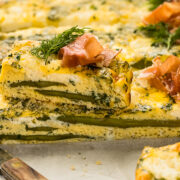
Asparagus Frittata Recipe
Equipment
- 9’’ square baking pan
- Saucepan
- Large Mixing Bowl
Ingredients
- 1 pound Baby Asparagus (or thin asparagus) – trimmed
- 8 large Eggs
- ¾ Cup Whole Milk Ricotta - DIVIDED (6 ounces total)
- 1/3 Cup Whole Milk (SEE NOTES)
- ¼ Cup Parmesan – finely grated, plus more for garnish
- 2 TBS Chives – thinly sliced, plus more for garnish
- 1 TBS Fresh Dill – chopped, plus more for garnish
- 1 tsp Dijon Mustard
- Kosher Salt & Pepper
- Optional Garnish Ideas: Prosciutto, Smoked Salmon, Arugula, Roasted Cherry Tomatoes, Fresh Herbs
Instructions
- Preheat oven to 375 degrees F. Grease a 9-inch or 8x10-inch baking pan with non-stick cooking spray (grease well!!). Line the pan with a sheet of parchment paper, cut to fit inside the pan with the edges slightly hanging over.
- Blanch and Shock Asparagus: Bring a saucepan of water to a boil. Season the water generously with salt. Add the asparagus and cook for 1-2 minutes, or until bright green and tender crisp. Use a large slotted spoon or tongs to transfer the asparagus to an ice water bath. Shock the asparagus to stop the cooking process. Drain, pat dry, and set aside.
- Prepare eggs: In a large bowl, whisk together the eggs, 2 tablespoons of ricotta, milk, parmesan, chives, dill and dijon. Season with ½ teaspoon salt and ¼ teaspoon pepper. Whisk well to thoroughly combine. Set aside.
- Assemble the frittata: Arrange half of the asparagus in the prepared pan in a single row. Pour the egg mixture into the prepared baking pan. Place the remaining asparagus in the eggs in a row. Dollop the top with the remaining ricotta. Season lightly with salt and pepper.
- Bake for 28-38 minutes (keep an eye on the frittata), or until the frittata is risen and just set (it shouldn't jiggle in the center!). Remove from oven and let cool in pan for 5 minutes. Carefully remove the frittata from baking pan by using both hands to grab parchment paper and lift frittata out. If stuck, carefully slide a butter knife around the edges of the pan to release. Transfer frittata to a platter.
- To serve: Cut into slices between the strips of asparagus. Top more fresh herbs, parmesan and prosciutto if using. For best taste, enjoy while warm or at room temperature!
Video
Notes
- Lining the pan: If you want to serve this straight from the casserole dish, you can skip lining the pan with parchment paper. Just make sure you generously grease the casserole dish with non-stick cooking spray! Also, I be especially careful not to overcook the frittata, as it will continue to cook from the residual heat of the baking dish!
- Baking dish: You can use a round 9-inch deep pie plate instead! Please follow the tips above about greasing the pan and watching the bake time!
- Make sure you pre-cook the asparagus! In order to ensure the asparagus inside the frittata is tender, you need to blanch the asparagus in salted boiling water for 1-2 minutes.
- Make sure you use full-fat dairy! While the asparagus frittata recipe below calls for whole milk, you can substitute heavy cream or half and half for a more rich mouthfeel! However, using 2% or skim milk is not recommended or your frittata will turn out watery. Likewise, do not completely omit the milk or your frittata will not be creamy or custard-like in consistency.
- Do not overcook the frittata! You want to bake the frittata until it the eggs are puffed, risen and just set. Over-baking the frittata will make the eggs dry and rubbery.
Nutrition
Did you make this recipe?
Mention @nospoonnecessary on Instagram and tag it #nospoonnecessary!
©No Spoon Necessary. All images and content are under copyright protection. Please do not use any images without prior permission. Please do not republish this recipe without prior consent. If you want to reference this recipe, please do so by linking directly to this post.

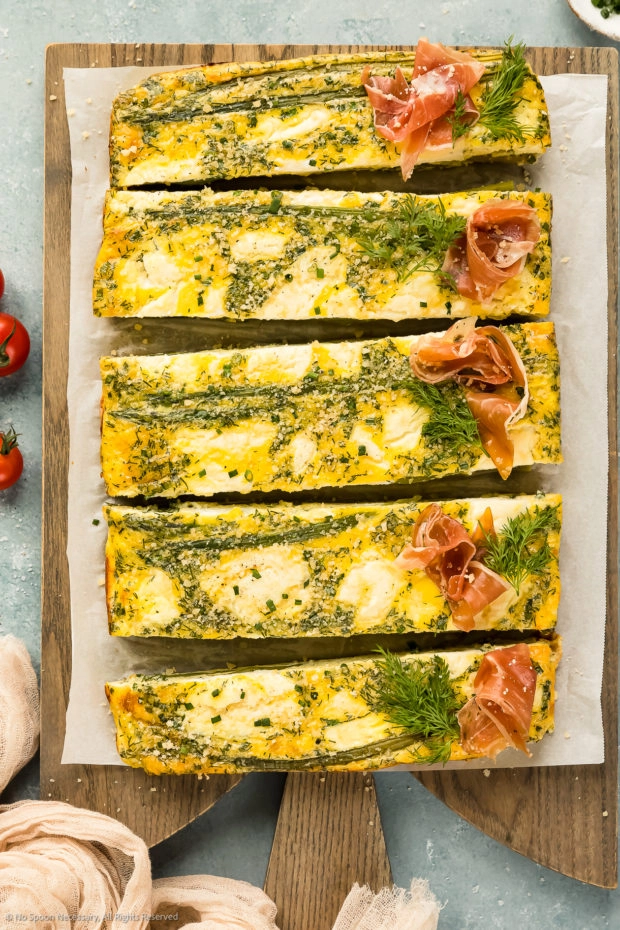
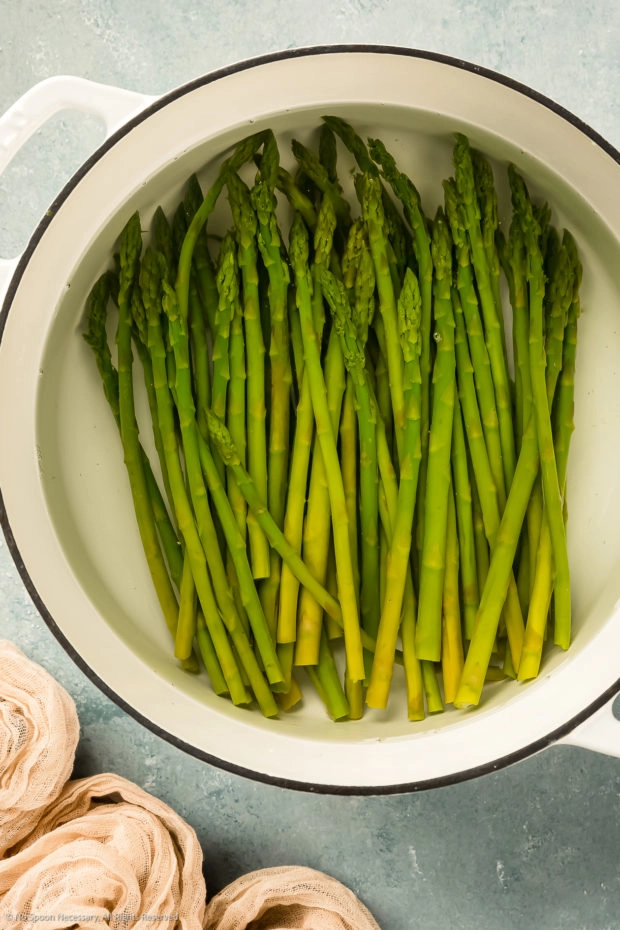
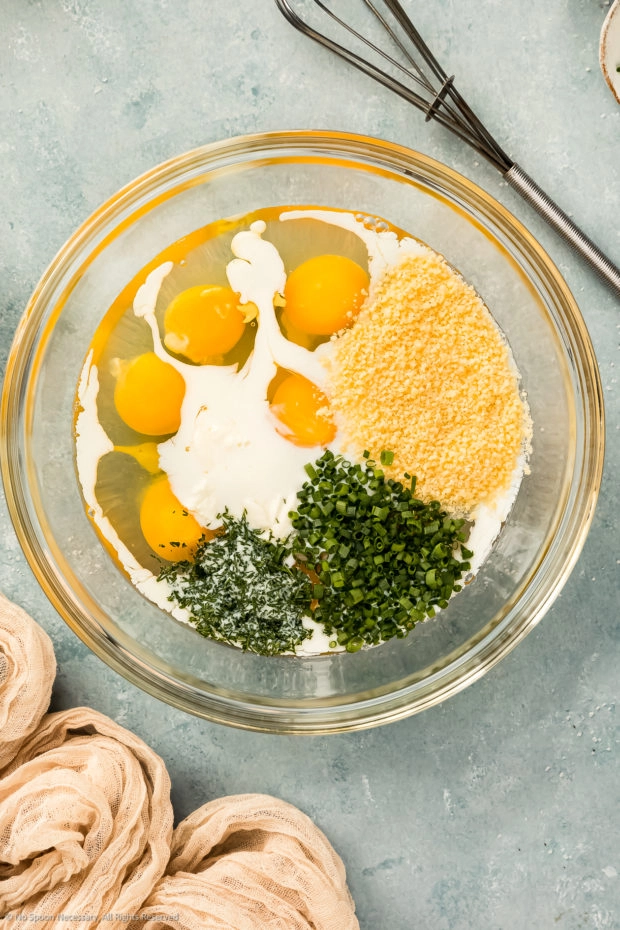
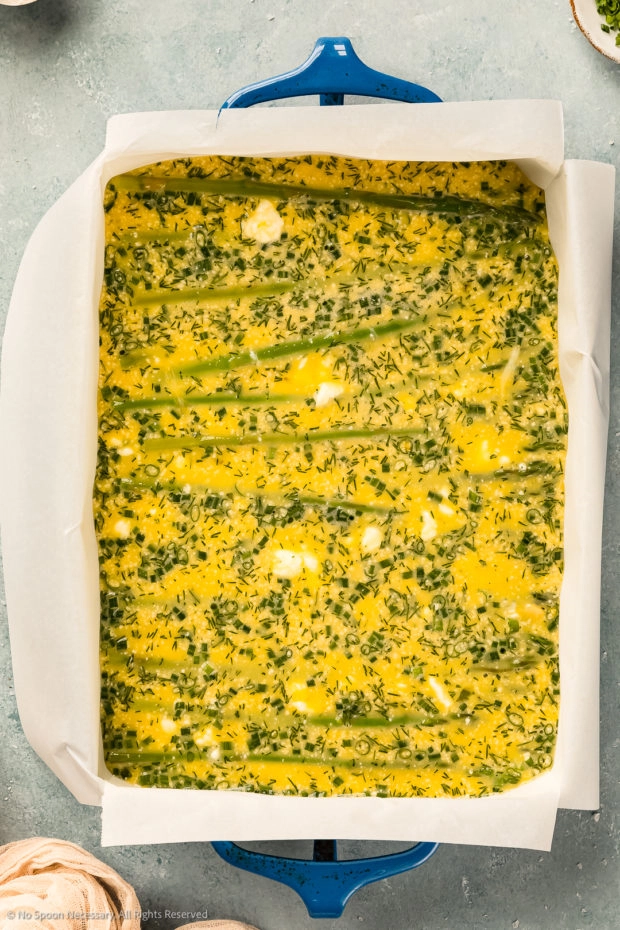
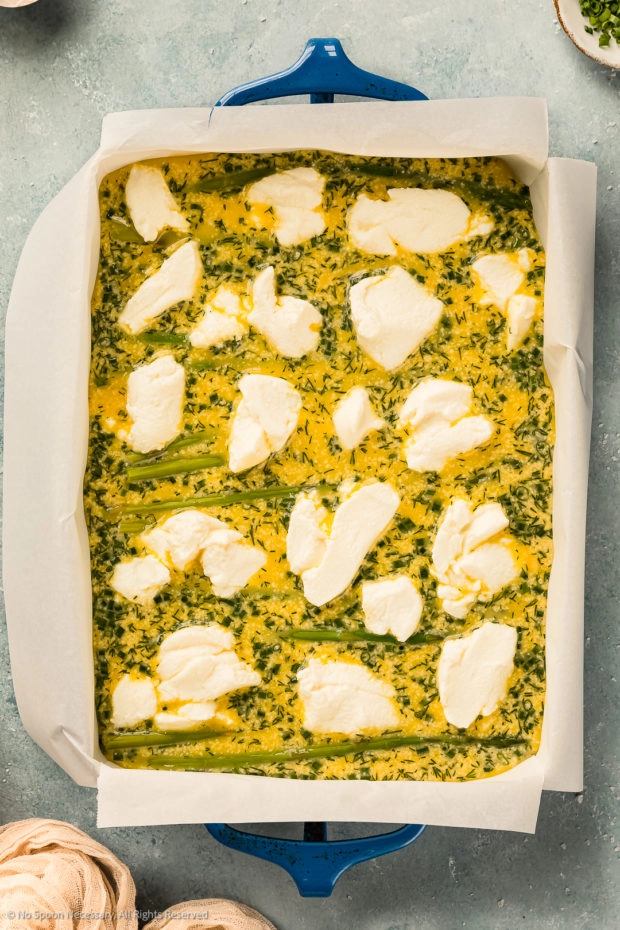
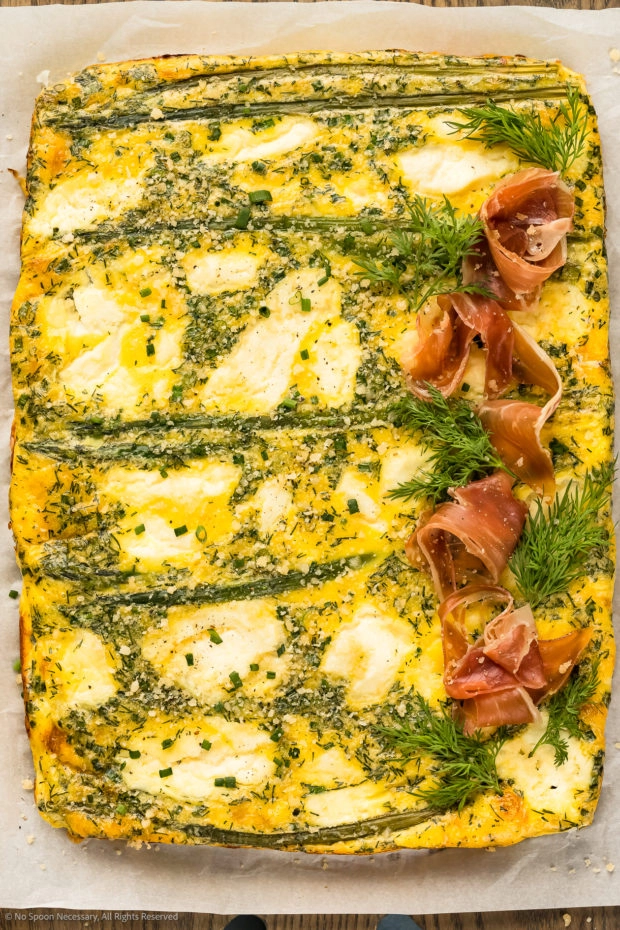
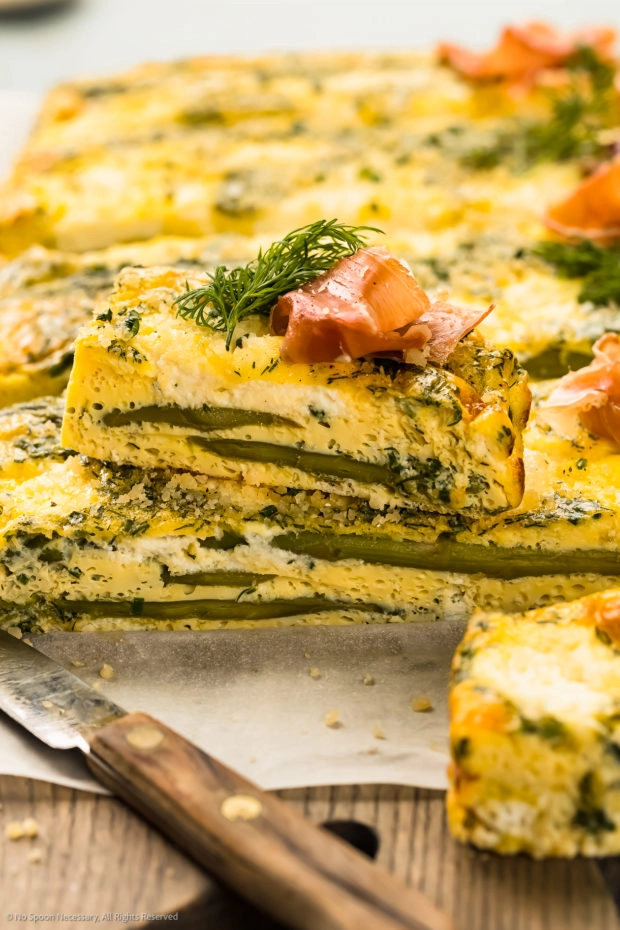
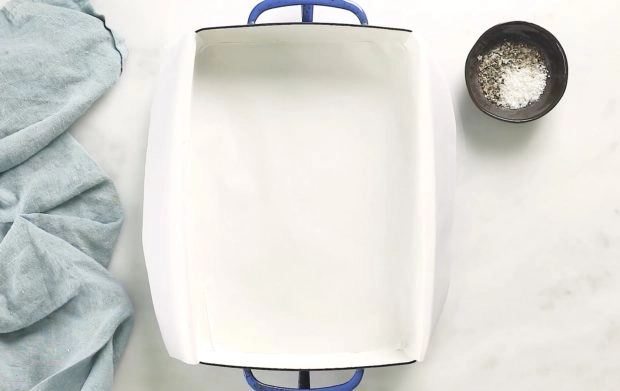
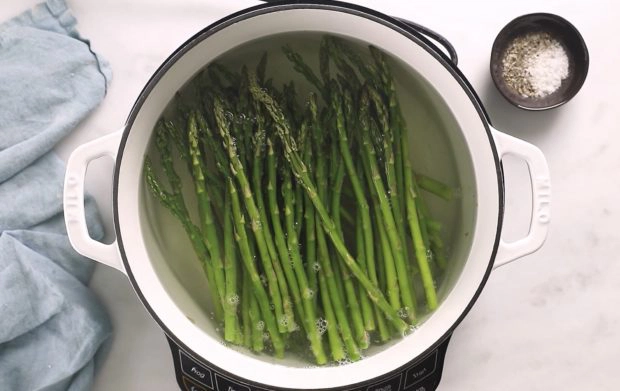
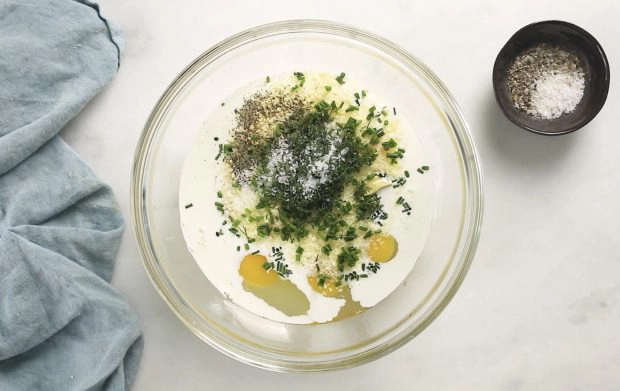
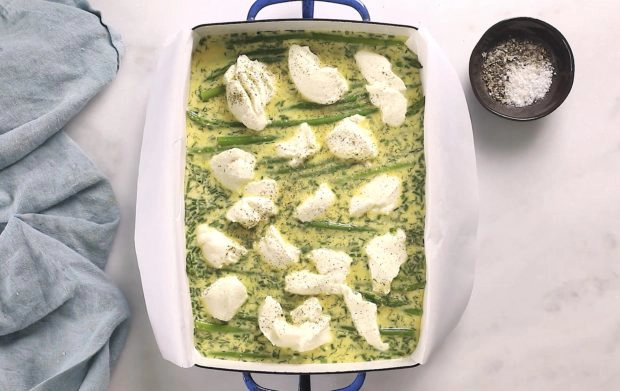
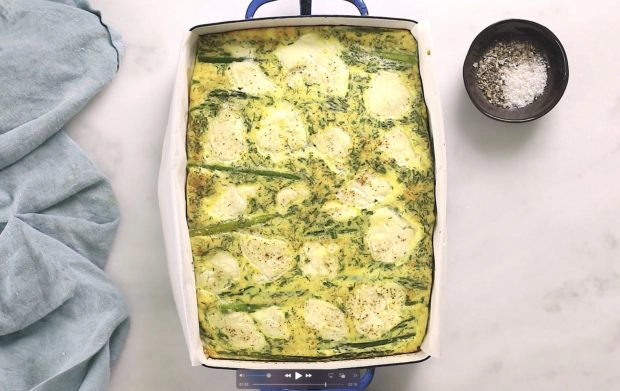
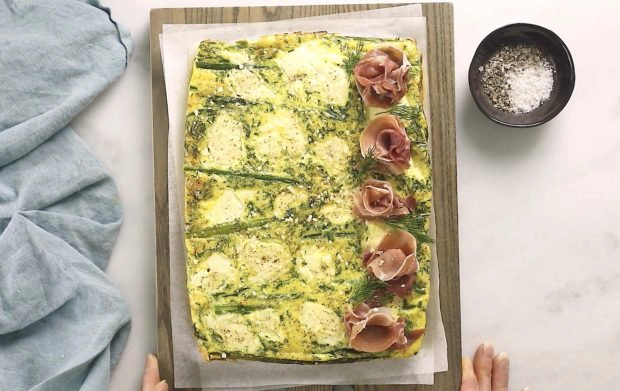
Jennifer @ Seasons and Suppers
Such a pretty frittata and love it in large size to feed a crowd! Asparagus and eggs are such a great combination, especially for Spring eating 🙂
Marissa
We had frittata for dinner three nights this week, lol! But yours looks better than the one I made. Loving the asparagus – all the spring vibes. Putting this on the menu while asparagus is still at its peak!
Kevin
Such an amazing combination of textures and ingredients to make this dish a great one to start your day with!
Kelsie | the itsy-bitsy kitchen
I can’t get enough asparagus right now–it’s one of my favorite veggies! I’m totally adding this to my Easter menu. UGH I can’t even wait to try it! Have a great weekend, Chey!
Ben|Havocinthekitchen
Oh I do love this fancy frittata all dressed up in spring colours and flavours! It indeed looks like a pizza. Perfect for this time of the year (or all year round). Well done!
Kelly | Foodtasia
Chey, this frittata looks fantastic! Nothing announces spring like asparagus. Love the ricotta sprinkled on top!
Mary Ann | The Beach House Kitchen
Save a slice for me Chey! I love spring asparagus. And frittatas are a regular at our house for breakfast, lunch or dinner. Can’t wait to give this recipe a try!
angiesrecipes
The prettiest spring frittata I have ever seen! You are so creative and talented, Chey.